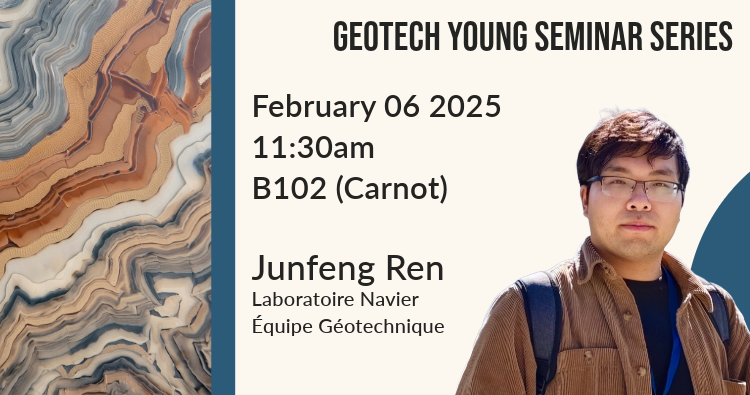
Geotech Young Seminar Series: Junfeng Ren (Navier)
Poro-elasto-visco-plastic behaviour of in-situ heated Callovo-Oxfordian claystone for the radioactive waste disposal
Abstract:
The Callovo-Oxfordian (COx) claystone, the host rock for the deep geological repository of the radioactive waste in France, is expected to experience thermal loading up to 90 °C due to the decay heat of radioactive nuclides. This seminar focuses on the hydro-mechanical behaviour of in-situ heated COx claystone. After resaturation under in-situ stress state, the samples were subjected to cyclic deviatoric stresses along different stress paths until failure. Elastic and plastic strains were decomposed through cyclic loading, enabling the analysis of elastic parameters and identification of the plasticity onset. Comparisons of strain during loading and unloading cycles revealed the visco-plastic behaviour of the material.
These findings provide important insights for evaluating the poro-mechanical behaviour of heated COx claystone.
The experimental data were used to develop and calibrate a poro-elasto-visco-plastic constitutive law. Asymmetric Cam Clay (ACC) model was used, coupled with a non-uniform scaling method to account for anisotropic plasticity, and the overstress model was incorporated for visco-plastic behaviour. The constitutive law was implemented in the finite element solver FEniCSx using the MFront tool. This numerical simulation tool will be used to analyse the thermo-hydro-mechanical response of the COx at the repository scale.
Short bio:
Hello everyone! Since October 2022, I work as a PhD student at Laboratoire Navier Navier. Before this, I obtained a Master’s degree in Road Engineering from Southeast University in China and an Engineer’s degree in Civil Engineering from ENPC in France. My PhD research focuses on understanding the thermo-hydro-mechanical behavior of Callovo-Oxfordian claystone, the host rock for the deep geological storage of radioactive waste in France. My aim is to develop the constitutive model, calibrate parameters with laboratory tests and simulate the underground structures to assess the performance of the claystone over the span of the repository.


